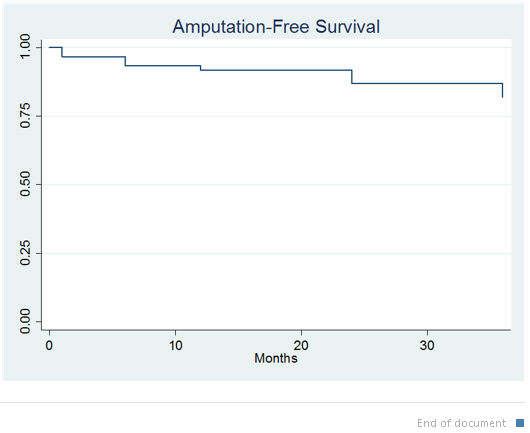Back to 2016 Annual Symposium ePosters
Isolated Common Femoral Endarterectomy and Iliac Stenting is Associated with Excellent Limb Salvage in Patients with Multilevel Disease
Andre Ramdon, Scott Damrauer, MD, Michael Golden, MD, Grace Wang, MD, Lewis Kaplan, MD, Venkat kalapatapu, MD.
Philadelphia VA Medical Center, Philadelphia, PA, USA.
Objective: Common femoral endarterectomy (CFE) and iliac stenting is the traditional treatment for inflow disease. We examined the efficacy of isolated CFE for limb salvage in a cohort of patients with multilevel disease
Methods: We performed a retrospective review of 62 limbs of patients undergoing CFE with or without iliac stenting at the VA hospital between 2009-2014. Kaplan-Meier (KM) analysis was used to determine limb salvage rate and amputation-free survival. Univariate as well as multivariate logistic regression was performed to determine the factors associated with major amputation or death.
Results: All patients were male, the mean age was 64.2(±6.3) years, there were 36.1% with CAD, 21.0% with diabetes, 29.0% with COPD, and 9.7% with renal insufficiency. The majority of patients (79.0%) had TASC C/D lesions, and 51.6% of patients were operated on for critical limb ischemia. Most patients (87.0%) underwent concurrent iliac stenting, and only a minority underwent femoral-popliteal bypass (19.7%). The mean preoperative ABI was 0.31 (±0.20), which improved to 0.67(±0.22) at one month, and was preserved at 24 months (0.67±0.31). Using Kaplan-Meier analysis, there was a 93.5% limb salvage rate and an 82.0% amputation free survival rate at 3 years (Figure). Logistic regression identified COPD (OR=10.4, p=0.01), diabetes (OR=8.4, p=0.03), and internal iliac artery occlusion (OR=6.7, p=0.02) as independent predictors for amputation or mortality.
Conclusions: CFE can be performed singly in the presence of multilevel disease and is associated with excellent limb salvage. The presence of diabetes, COPD and internal iliac artery occlusion was associated with major amputation or mortality in this subset of patients. 
Back to 2016 Annual Symposium ePosters
|







